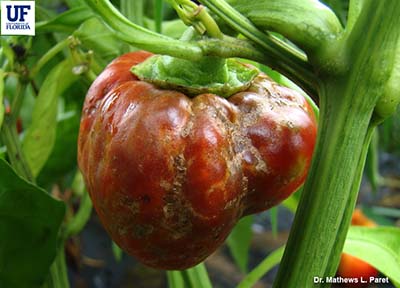Viruses and Plant Disease

Pepper with tomato spotted wilt virus symptoms.
Dr. Mathews Paret, U-scout program of the University of Florida
Viruses are among the smallest and simplest pathogens. In fact, they are so small that they cannot be seen with the naked eye or even a conventional light microscope—only an electron microscope is powerful enough.
Viruses are unique from bacteria and fungi because they are not classified as living organisms. This is because they are dependent on having a living host in order to replicate.
The first known virus was the tobacco mosaic virus, which was discovered in 1898. Since then, more than 5,000 have been described. It is important to understand that not all viruses cause disease—some can replicated within a host without causing harm to the host.
Pathogenic viruses (that is, viruses that do cause disease) are not always host specific. A single virus may cause diseases in more than one plant species, and the symptoms in each plant may be distinct. For example, the virus that causes ring spot in tobacco also causes a bud blight in soybeans.
One of the troubles with plant pathogenic viruses is that once a plant is infected, little can be done to get rid of the virus. Because of this, prevention is the best strategy.
Viruses that affect animals typically enter the cells by simply passing through the cell membranes. But, because plants have tough cell walls, viruses that affect plants need a wound in order to enter the cell. A wound can happen naturally, like when roots branch, or they can be introduced when a plant is damaged by nematodes, insects, or pruning. In some cases, the organism creating the wound can also be carrying the virus and then introduce it to the plant.
Viruses are often transmitted from one plant to another by vectors, e.g., organisms that transmit disease. Sap-feeding insects like leafhoppers, planthoppers, aphids, and whiteflies can transfer viruses from one plant to another. Gardeners can also transfer viruses from an infected plant to a healthy plant when pruning or propagating, if care is not taken to sterilize tools between cuts.
Gardeners typically know viruses by their descriptive names that reference the disease they cause, in part because their full scientific classification is somewhat complicated.
- Citrus tristeza virus causes decline and eventual death of citrus trees on sour orange rootstock. It is spread via aphids.
- Tomato spotted wilt virus causes yellow or brown rings to form on tomato plant leaves and/or fruit, wilting, and sometimes lopsided growth. It also affects tobacco, pepper, watermelon, impatiens, gloxinia, and other ornamentals.
- Cucumber mosaic virus can cause a range of symptoms from a mild mosaic to severe deformation and stunting. It affects celery, cucumber, squash, cantaloupe, tomato, and sometimes pepper.
- Rose mosaic virus causes leaf discolorations including white or yellow spots or lines that may only appear occasionally depending on conditions. It will not kill a rose but can reduce growth, flower production, and lifespan.
This is by no means an exhaustive list of plant viruses, but it does cover some of the more commons ones.

